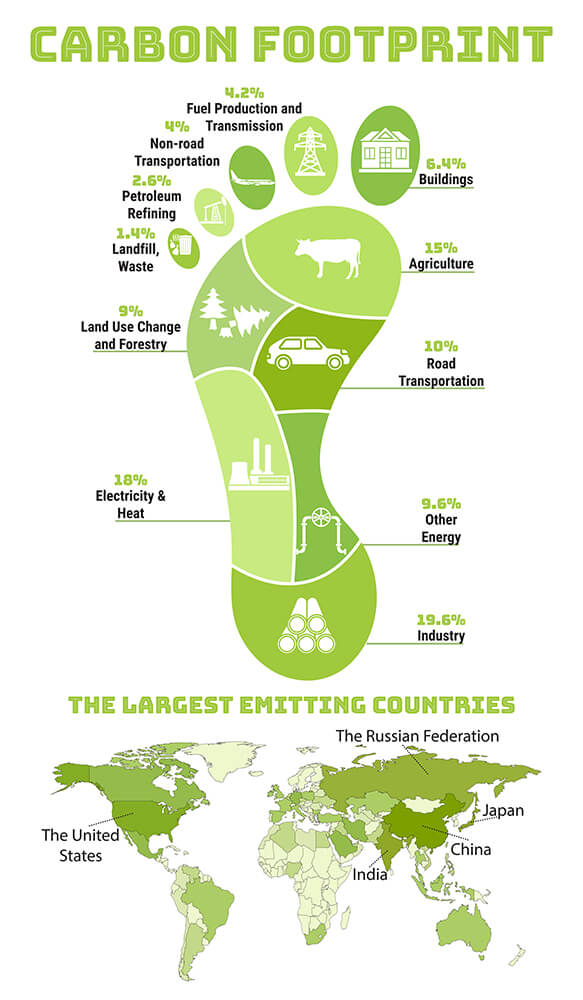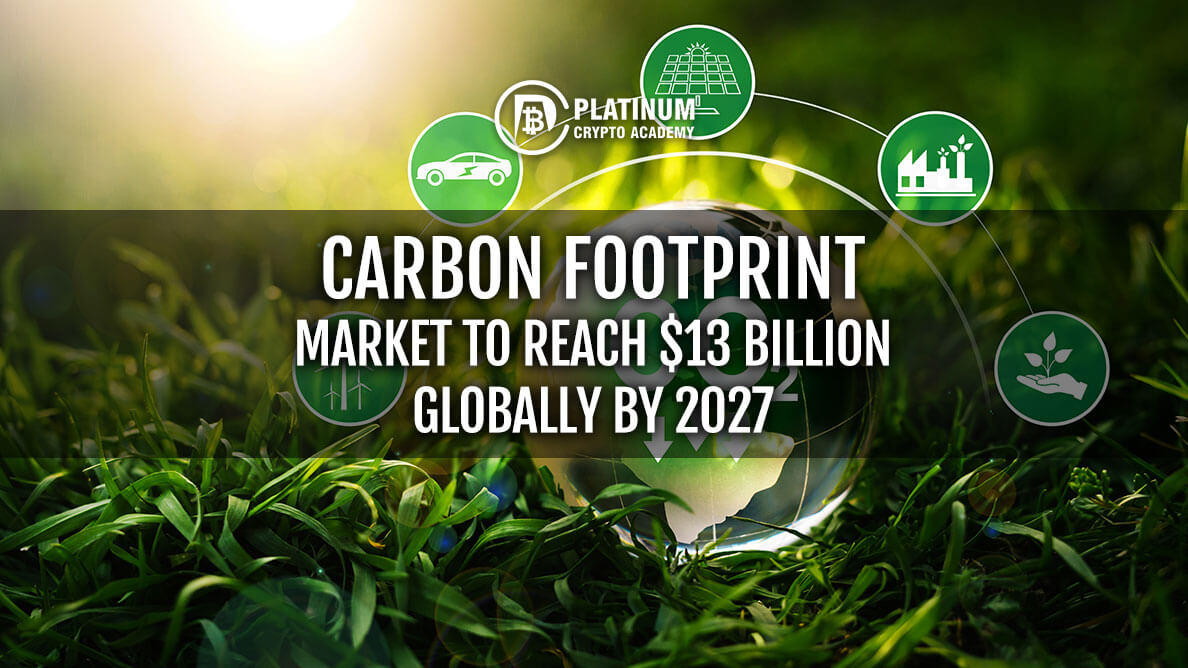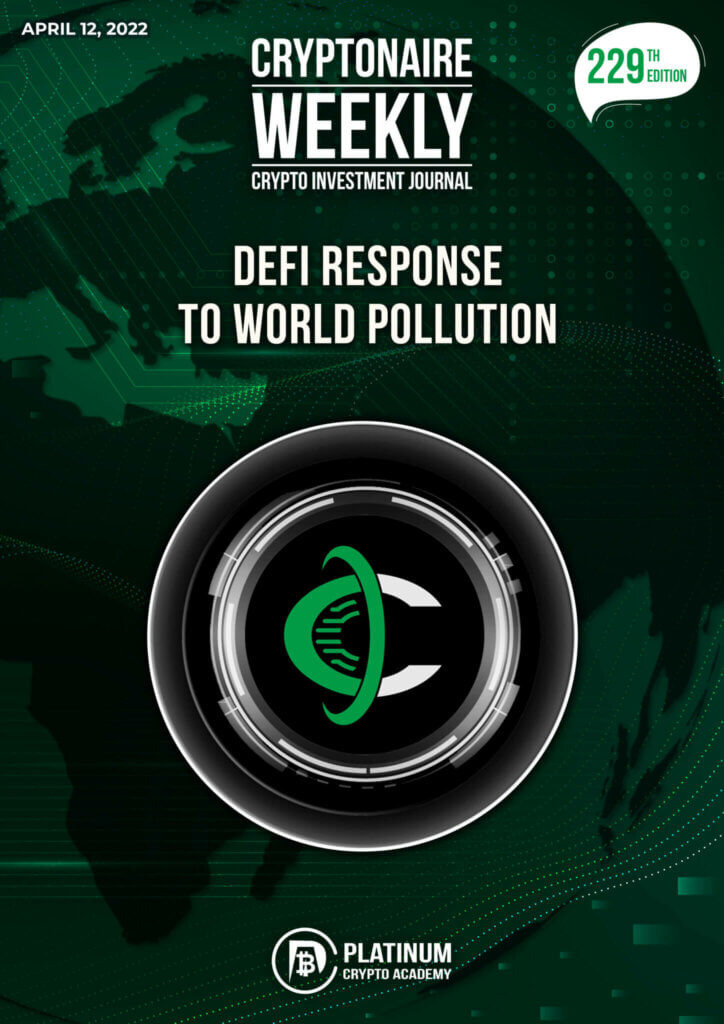Quick Links
Introduction
Our relationship with planet Earth has changed significantly in the last few decades. In the modern world, you or everything you own or use has its own carbon footprint and is pretty much impossible to leave no carbon footprint in reports behind.
However, that should be all the more reason to find out immediate solutions to the problem. All you need to do is look at your actions and choices and discover your own easy solutions to mitigate climate change, which is also sustainable.
A recent study estimated the global carbon footprint market is set to reach US $13 billion by 2027.
In fact, governments, companies and individuals now care a lot more about the environment than they did few decades ago. Besides, pollution is also one of the main reasons for several diseases, including fatal ones, that are affecting humans, plants as well as animals.
An easy solution to tackling the rising pollution globally is by measuring and reducing our carbon footprint, which is a very powerful tool to understand the impact of personal behavior on global warming. It also contributes significantly to climate change that is affecting everyone living on planet Earth.
In this article, you will discover how to measure and reduce carbon footprint in your organization. You will also find out how organization’s carbon footprint report can get more value for your brand or organization.
What is Carbon Footprint
Carbon footprint is the total greenhouse gas (GHG) emissions caused by an individual, event, organization, service, place or product. It accounts for all the six Kyoto GHG emissions including carbon dioxide, methane, nitrous oxide, hydrofluorocarbons, perfluorocarbons, and Sulphur hexafluoride.
The carbon-containing gases can be emitted through burning of fossil fuels, land clearance, production and consumption of food, manufactured goods, materials, wood, roads, buildings, transportation, and other services. A growing awareness over the risks of climate change for businesses is driving corporate investments in carbon footprint management.
Carbon Footprint Report
A carbon footprint report is the summary and compilation of the total amount of GHG emitted, as a result of an individual’s actions over a period of time – generally measured over a year. It includes both direct and indirect sources of emissions.
There are two types of carbon footprint that affects businesses – one that measures an organization’s overall activities, and the other that looks at the life cycle of a particular product or service.
Calculating either or both of these footprints is an essential starting point for any wider work to reduce your organization’s carbon emissions. It alos gives you an initial benchmark against which to measure your progress.
Measuring Carbon Footprint
An organizational carbon footprint measures the GHG emissions from all the activities across the organization, including energy used in buildings, industrial processes and company vehicles.
A product carbon footprint measures the GHG emissions over the whole lifecycle of a product – from the extraction of raw materials and manufacturing, right through its use and final re-use to its recycling or disposal.
Reporting their carbon footprint is a mandatory requirement for many companies, especially those listed on American or European stock exchanges. Besides, there are other companies, which choose to report their carbon footprint as part of their Corporate Social Responsibility (CSR) strategy.
Ultimately, reporting your carbon footprint will help your business to understand its carbon emissions and identify opportunities to reduce your costs, improve your reputation and manage long-term business risks.
Carbon Footprint Facts
The global market for carbon footprint report is projected to reach US $13 billion by 2027 from US $8.7 billion estimated in 2020, according to a report titled Carbon Footprint Management – Global Market Trajectory and Analysis.
Solutions, one of the segments analyzed in the report, is projected to grow at 5.6% to reach US $7.7 billion by the end of the analysis period.

Why Carbon Footprint Report Matters
All businesses have the opportunity to reduce their carbon emissions and the business case for doing the same is only growing stronger. Higher and more volatile energy costs are increasing the value of energy savings. Besides, companies that manage their carbon emissions responsibly, can enhance their brand value and make themselves more attractive to potential customers and investors.
The carbon footprint analysis report of Carbon Trust can be tailored to support the needs of your organization. Its work for product and supply-chain footprint measurement include 28,000 certifiable product footprints, and a range of services that measure the entire value-chain footprint of an organization and even whole industries. The Carbon Trust team also created the product carbon footprint measurement software that is being used by companies in 17 countries.
The Carbon Trust Standard
The Carbon Trust Standard is the world’s leading independent certification of an organization’s impact on the environment by verifying action on energy use and associated GHG emissions, water use and waste output.
It recognizes organizations that take a best practice approach to measuring and managing their environmental impacts, achieving real reductions of carbon footprints every year. The standard provides a framework for organizations to enhance their operational sustainability, improve efficiency and resource management, while cutting costs at the same time.
The certification offers some real advantages which include enhancing reputation, delivering efficiencies and facilitating compliance, details of which are explained below.
Enhancing reputation – The certification drives awareness of your environmental credentials among your stakeholders, customers and staff. Being recognized as an independently-verified environmentally responsible organization distinguishes your brand in a crowded marketplace. It also improves staff morale, retention, and the ability to attract new talent.
Delivering efficiencies – it benchmarks your company’s resource management performance and engage staff and customers to reduce resource use and cut costs.
Facilitating compliance – The Carbon Trust Standard certification helps the organization to be prepared for robust demonstration of performance under voluntary and mandatory environmental reporting frameworks, such as mandatory reporting of GHG emissions, EU regulations including ESOS and CRC Energy Efficiency Scheme. It also helps to comply with contracting and procurement requirements for independently-verified environmental impact data and management frameworks.
Why Carbon Footprint Report
Calculating an organization’s carbon footprint is the first step towards its reduction. You can report the figure to authorities or gain independent certification for marketing or CSR purposes, or even to meet the requirements of climate change legislation.
There are two primary reasons to calculate the organizational carbon footprint report. One is to manage GHG emissions and reduce it over time and the other reason is report the footprint accurately to a third party.
In the UK, all listed companies are required to report their annual GHG emissions in their directors’ report. The UK’s Department for Environment, Food and Rural Affairs has estimated that reporting will contribute to significant savings of CO2 emissions.
Quantifying an organization’s GHG emission sources will help understand what impact the organization is having on climate change. This will help its management identify and prioritize areas for reducing emissions, which often result in cost savings as well.
The Carbon Disclosure Project (CDP), a non-profit organization, collects and distributes information about carbon emissions by organizations and holds the world’s largest database of corporate climate change information. This data can be viewed by anyone and is often of particular interest and use to investors, policymakers and their advisors, government bodies and academics.
Increasingly, companies are calculating their carbon footprint for sharing the information with other organizations or for public disclosure. This exercise helps in meeting the mandatory reporting requirements of climate change, set a science-based target to reduce GHG emissions, report emissions as part of CSR or for marketing purposes.
It also helps in responding to requests from customers and investors for carbon emission data, participate in carbon reporting initiatives, and measure and report your emission levels as part of a carbon reduction or offsetting strategy.
If you plan to publicly disclose your carbon footprint report or the progress with its reduction, it is important to use a robust approach to calculating your carbon emissions. The GHG Protocol is the standard that majority of the organizations follow. Obtaining independent certification or validation can give your external stakeholders more confidence that the methods have been used correctly and the results are accurate.
The GHG Protocol is an accounting tool used by organizations and governments to understand, quantify, and manage their GHG emissions. It provides the world’s most widely used GHG accounting standards.
Created in 2001 jointly by the World Resources Institute and the World Business Council for Sustainable Development, its been used by over 1,000 businesses and organizations globally. In 2016, at least 92% of the Fortune-500 companies responding to CDP used the GHG Protocol directly or indirectly.
Measures to Reduce Carbon Footprint
There are many ways by which carbon footprint can be reduced individually and most of them require simple and easy changes to be implemented.
Using sustainable transport whenever possible – Walking or riding a cycle can completely avoid carbon emissions from driving. Using public transportation can drastically reduce carbon dioxide emissions because individual private vehicles cumulatively add up to the emission volume.
Moreover, low carbon vehicles are an option available that allow driving but reduce overall carbon emission. Electric cars emit no carbon dioxide if the electricity they are charged with, has no associated carbon emissions.
Efficient driving – Driving more efficiently by not speeding unnecessarily, as these driving styles can reduce mileage by 33%, which means more carbon emissions.
Improving home energy efficiency – Insulating and sealing your home and office properly and utilizing weather stripping and caulking to ensure windows, doors and skylights do not have any air leaks. Additionally, using energy efficient appliances, can reduce emissions that contribute to a larger carbon footprint report. Upgrading incandescent light bulbs to LEDs is also a way to reduce emissions.
Recycling – It helps to reduce carbon emissions that are associated with the extraction of resources, transport, manufacturing and disposal of goods.
Food miles – A significant amount of greenhouse emissions are produced as a result of producing and transporting food. So, the emission can be reduced by eating food grown closer to home.
Reduce beef and dairy intake – Production of beef and dairy on large farms produces a large amount of greenhouse gases.
Reduce water usage – Reduction of water usage lowers the amount of energy required to pump, treat and heat water. Conservation, along with using water saving shower heads, toilets, dishwashers and washing machines can help in this aspect.
Carbon Footprint Issues
Carbon footprint measurement and reduction are fraught with issues and the key among them is the cost of compliance. While the latter has reduced significantly over the years, many SMEs sare still not convinced that it is financially worthwhile to invest in reduction of carbon footprint. There is a good chance that they want to take a step towards reducing carbon emissions for purely ethical reasons.
If the issue of carbon footprint is not addressed, then the fast pace of global warming affecting our planet will result in frequent destructive weather events, more countries experiencing frequent droughts, more extinction of wildlife due to changing ecosystem and more people getting displaced or getting negatively affected.
While carbon emissions are something we closely associate with visible output, online and digital companies are just as responsible for how much carbon dioxide they produce. The internet itself, a seemingly digital entity, contributes to the carbon footprint of a lot of businesses.
It might feel odd to associate something so far removed from the industrial world with pollution, but the internet still relies on a number of real-world factors to make it tick. These factors contribute to GHG. For instance, manufacturing, shipping, powering as well as cooling contribute to CO2 pollution.
Computers and smartphones are mass produced and shipped off across the world for use. Then, the servers needed to house and manage the data spread throughout the internet – all these are bad producers of GHG.
The powering and cooling processes of smart devices and computers require electricity drawn from local grids. The generation of this electricity is done in many ways and some of them will have a negative impact on the environment.
Reports have found that small businesses contribute 6% of the total UK annual carbon emissions. This 6% still accounts for 25.8 million tons of CO2 being pumped into the atmosphere every year. Larger businesses would contribute up to 8% while all the other sectors accounted for the remaining 86%.
How to Reduce Carbon Footprint
Now that you have a better understanding of the issues related to carbon footprint and how it may affect your businesses, it is time to take actionable steps towards reducing your carbon footprint. As per guidance laid out by the GHG Protocol, businesses are able to measure the amount of carbon they produce by breaking each channel of production down into three main categories – direct emissions, indirect energy emissions, and other indirect emissions.
Direct emission is the easiest category to collect data for, as it incorporates all the emissions which your company is responsible for such as the fuel for your cars, natural gas burned at your site and the refrigerant losses.
The indirect energy emissions are perhaps the most difficult scope to actually measure, as it needs to consider indirect contributions from third-party aspects of your business. These include shipping and distribution, overall supply chain, commute of all your employees, water supply and treatment etc.
Carbon Footprint reporting methodology
Google Cloud offers Carbon Footprint reporting to help customers run their business with as light a footprint. The climate impacts of products purchased from Google Cloud are provided to customers so that they can report and take action.
Key Concepts
Google Cloud
It is a computing platform which is used for resources like memory, storage, networking, etc.
Internal services
It’s a software functionality which runs on Google’s data centre machines.
Electricity
It is one of the largest sources of Google cloud.
Conclusion
Reporting of carbon footprint and efforts to reduce it at your organizational level can help you differentiate your product or service and enhance your brand image in from of your stakeholders. The latter feel more positive about a company that has reduced the carbon footprint of their products.
Certifying your product carbon footprint allows you to gain an internationally recognized, fully independent measurement that can be used to communicate your product’s resource efficiency, to drive sales, reduce costs and increase brand loyalty. The underlying corollary, of course, is a better and cleaner planet for us.
Please contact us for more information about how we can help you baseline your Carbon Footprint Report, and start you on your journey to Carbon Neutrality and ultimately Net Zero.
Resources:
Environment and Carbon Footprint Report 2022
Greenhouse gas reporting: conversion factors 2022
Global Carbon Footprint Management Market Report 2022-2026




